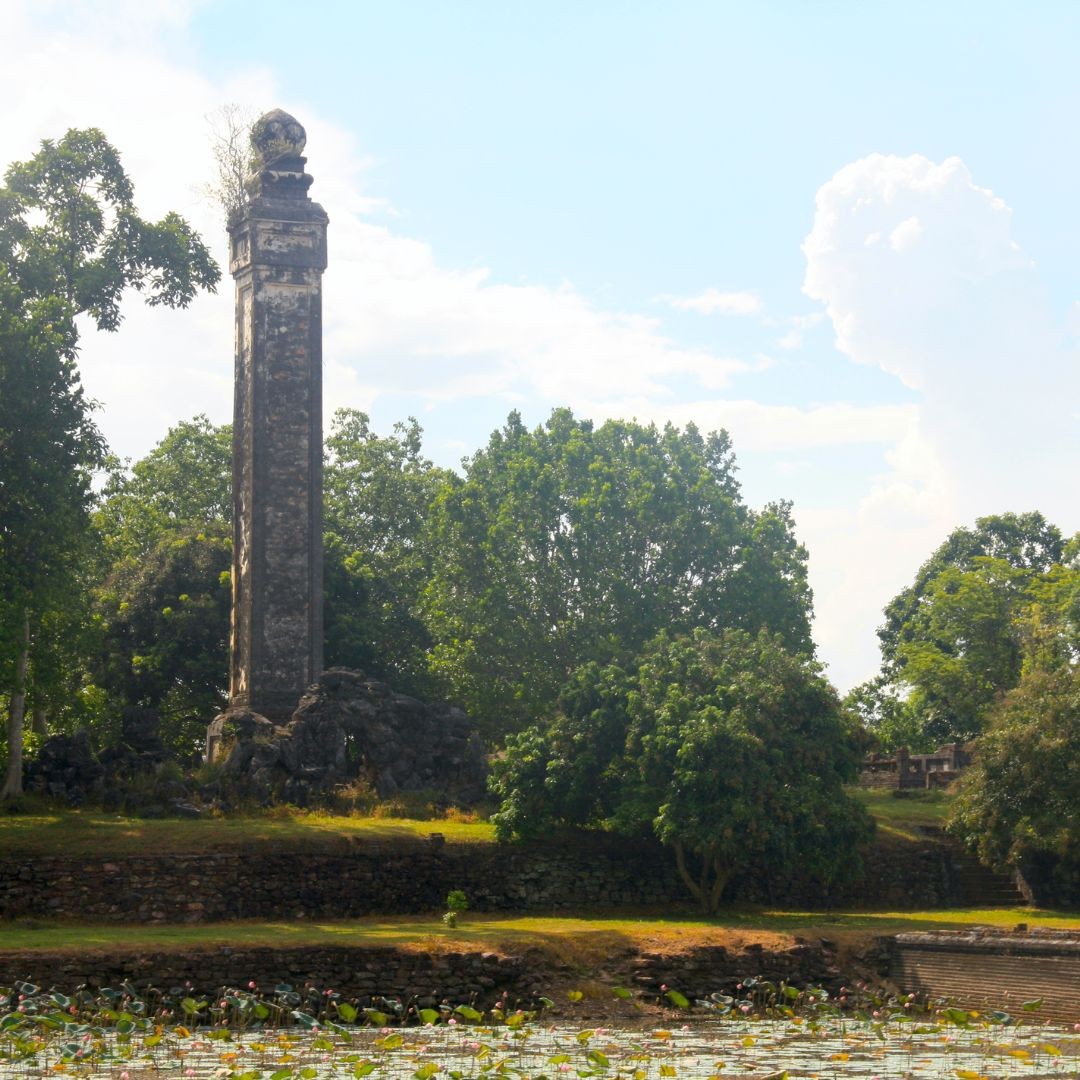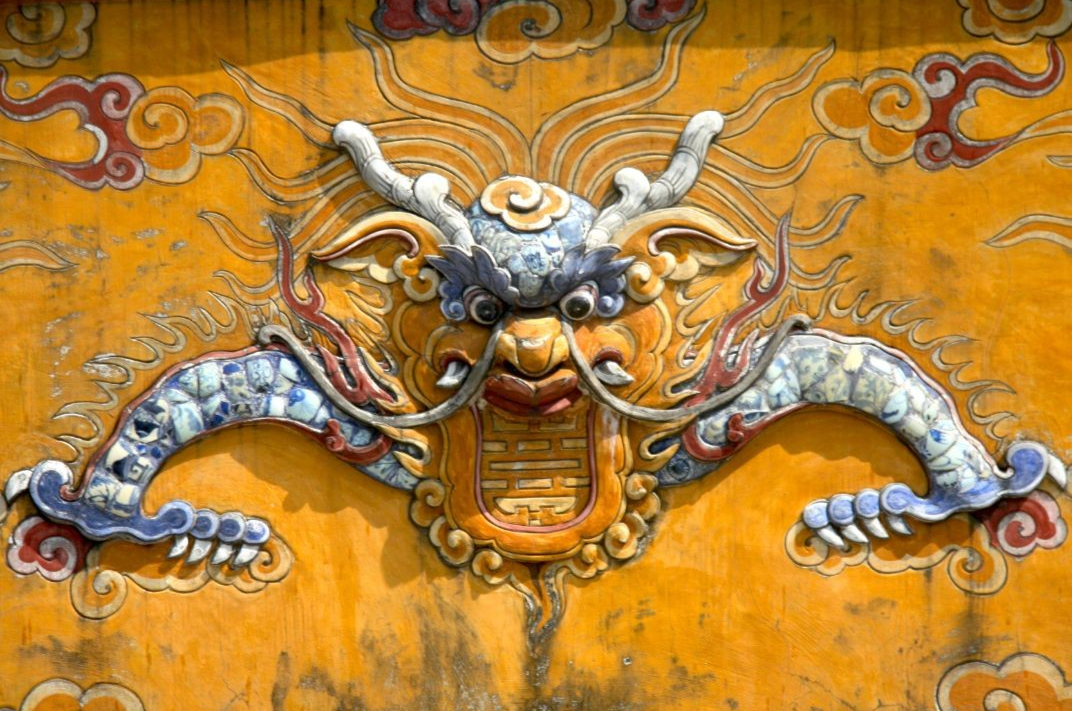As the night falls on Central Vietnam, a lively tune reverberates across the Perfume River from a fleet of illuminated dragon boats. Guitars and flutes accompany the chorus of female singers adorned in majestic robes. These performers are skilled in “nha nhac” or “elegant music,” an ancient musical style that dates back to the 13th century. Certain songs were sung during religious ceremonies or royal banquets, believed to summon ancient deities and lost spirits. These enchanting melodies might also reach the noble ghosts that may linger in the city’s numerous tombs.
Hue, the former capital during the Nguyen dynasty, preserves Vietnam’s royal history. The Nguyen rulers oversaw a period of transformation in Vietnamese history, asserting their distinct Vietnamese identity after centuries of Chinese dominion. However, the monarchy eventually embraced French colonialism, evident in the European influence seen in later tombs such as the Mausoleum of Emperor Khai Dinh.
Hue’s tombs and relics provide a captivating experience for visitors. Despite being the resting place of former royals, these tombs now serve as popular tourist attractions, offering a glimpse into history, culture, and mystique.
Ho Quyen – Vietnam’s Beastly Colosseum
 |
| Where elephants once walked. Photo by Glen MacDonald. |
While the Roman Colosseum dwarfs Ho Quyen in size, its history is no less bloody. Instead of gladiators, Hue’s royal court gathered at this venue to witness tiger-elephant fights.
Prior to the construction of the arena, the court observed these spectacles from a nearby island on the Perfume River. However, there were several instances of people getting injured or even killed by the tigers or elephants. After a tiger attempted to attack Emperor Minh Mang, the court decided to host these events in a safer location.
The fights, held annually, served as both entertainment and training for the elephants. The tigers’ claws and fangs were removed, ensuring the elephants’ victory.
The last recorded event occurred in 1904. Historian Phan Thuan An collected testimonials and reconstructed the thrilling clash of animals:
“When the female elephant entered the arena, she seemed confident, walking back and forth in front of the tiger without fear. King Thanh Thai praised the elephant, saying, ‘This creature is very brave.’ Suddenly, the tiger pounced on the elephant’s forehead, using its thousands of pounds of strength to push and squeeze. When the elephant lifted her head, the tiger fell to the ground, and the elephant used her foot to trample the tiger to death…”
The park is also the unofficial resting place for warrior elephants that served the Nguyen Lords.
Today, the once-bustling arena sits in a quiet corner of Hue. Local residents enjoy iced tea in the shade, watching over the structure. Ferocious battles have made way for tranquil tea sessions. While gazing at the sun-kissed stones, one might hear the mournful trumpet of slaughtered elephants, only to realize it is just a passing motorist’s horn.
 |
| Tiger gates. Photo by Glen MacDonald. |
Tomb of Thieu Tri – Serenity among Ruins
 |
| Royal ruins. Photo by Glen MacDonald. |
Western missionaries arrived in Vietnam in the 16th century with the goal of spreading Roman Catholicism and eradicating local religions. The initial missions, led by Portuguese and Spanish priests, did not yield significant results. It was only in the late 18th century, as the number of Vietnamese Catholic followers grew, that French priests gradually replaced their Portuguese and Spanish counterparts.
Like his predecessors, Thieu Tri, the third Nguyen king, was wary of the French missionaries and planned to execute them. While many of his officials chose not to carry out his orders, Thieu Tri’s fierce opposition to colonial powers has been acknowledged by historians.
 |
| Thieu Tri’s pillar. Photo by Glen MacDonald. |
 |
| A lotus-filled oasis by Thieu Tri’s tomb. Photo by Glen MacDonald. |
Thieu Tri’s tomb, known as “Xuong Lang” or “the tomb of serenity and peace,” was originally surrounded by lush gardens and overlooked expansive rice fields. Today, it remains little more than a ruin. Next to the ancient tomb is a vibrant lotus garden, teeming with dragonflies and butterflies. As it is off the beaten path for most tourists, the spirits of Thieu Tri and his court are often undisturbed.
Mausoleum of Emperor Tu Duc – The Last Free King of Vietnam
 |
| The eternal home of Tu Duc. Photo by Glen MacDonald. |
As the longest-reigning ruler of the Nguyen Dynasty, Emperor Tu Duc’s life was marked by tragedy. It was under his rule that Vietnam ceded land to the encroaching French colonists, including Hanoi, opening it up to international trade. This marked the beginning of French colonialism in Vietnam and led to the decline of the Nguyen Dynasty’s power. Adding to his woes, Tu Duc was unable to father a male heir, causing anxiety and uncertainty about the future of the royal lineage.
 |
| Tu Duc on the throne. Photo by Glen MacDonald. |
To escape the troubles of his kingdom and court, Tu Duc created his own sanctuary within Hue. In the midst of lush woods, he built an elegant boathouse near a serene lake. Tu Duc would often sail from the boathouse to a small island, where he would leisurely hunt for small game. This paradise would eventually become the site of his grand tomb.
As you stand by the lake, envision the emperor paddling towards his cherished island, leaving behind the burdens of the court. Perhaps, the spirit of Tu Duc still wanders through the well-preserved forests and takes respite near the lake, admiring the many tourists capturing photos of his picturesque realm.
 |
| Tu Duc’s stele. Photo by Glen MacDonald. |
Although his grand tomb serves as his final resting place, Tu Duc is rumored to have been buried elsewhere. According to local legends, loyal servants discreetly moved his body to a secret location to protect their king from grave robbers. The servants themselves were then executed by the royal court to ensure the location remains forever hidden.
In the absence of a male heir, Tu Duc adopted three of his nephews, Duc Duc, Kien Phuc, and Dong Khanh. Following Tu Duc’s death, Duc Duc ascended the throne but was quickly dethroned three days later for his perceived decadence, as the royal court believed he was unsuitable for a country on the verge of French occupation. Later, Kien Phuc was named the heir but only ruled for a few months before his untimely death. Ironically, Kien Phuc’s tomb lies just a few meters from his adoptive father’s.
Tomb of Emperor Dong Khanh – A Site of Eurasian Beauty
 |
| The gateway to the emperor’s tomb. Photo by Glen MacDonald. |
Once the French colonists entered Vietnam, their influence became ubiquitous and intertwined with Vietnamese culture. This unique blend is especially evident in the tomb of Emperor Dong Khanh, who reigned for only four years.
Prior to succumbing to illness, Dong Khanh wholeheartedly embraced French culture. He enjoyed drinking Bordeaux wine and canned milk, gifts from the French. He also took pleasure in French-made toys. Despite his failure to suppress Vietnam’s revolutionary movement, Dong Khanh was favored by the French for his cooperation as a diplomat. The king’s life was immortalized in French photographs, breaking from the tradition of the Nguyen Lords who avoided being photographed by outsiders.
 |
| Here be dragons. Photo by Glen MacDonald. |
 |
| Experience the colors of a grand tomb. Photo by Glen MacDonald. |
 |
| A fierce graveside guardian. Photo by Glen MacDonald. |
The Tomb of Dong Khanh is an intricate blend of Eastern and Western influences. The design is inspired by Chinese tales, ancient Roman architecture, zodiac symbology, and depictions of the Napoleonic wars. Despite its somber purpose, the vibrant colors of the tomb create a charming and lively atmosphere.
Dong Khanh departed from tradition by allowing French photographers to capture his court, breaking the Nguyen Lords’ aversion to being photographed by outsiders. The photographs provide a timeless glimpse into the royal splendor of Vietnam’s imperial past.
 |
| Dong Khanh on the throne, photographed by French colonizers. |
 |
| The final resting place of Dong Khanh. Photo by Glen MacDonald. |
Mausoleum of Emperor Khai Dinh – Resting in Eternal Elegance
 |
| Emperor Khai Dinh’s Mausoleum. Photo by Glen MacDonald. |
Emperor Khai Dinh ascended the throne at a time when the Vietnamese people had grown disillusioned with the Nguyen Kings, who they saw as puppets of colonial masters. Khai Dinh increased taxes to fund his lavish lifestyle; instead of engaging in courtly affairs, he preferred the company of his loyal bodyguard. To appease the French, Khai Dinh ordered the romanticization of the Vietnamese alphabet, disregarding centuries of Vietnamese written tradition.
 |
| Statues of Khai Dinh’s court. Photo by Glen MacDonald. |
 |
| An impressive steeple. Photo by Glen MacDonald. |
The interior of the tomb resembles a European villa, adorned with exquisite frescoes, a stunning chandelier, and compartments embellished with porcelain and colorful glassware. In the center of the room stands a bronze statue of Khai Dinh, forever gazing towards the western horizon and the setting sun.
 |
| Khai Dinh, forever on his throne. Photo by Glen MacDonald. |
Hue’s Abandoned Water Park – A Haunting Ground for Commoners
 |
| Hue’s sleeping dragon. Photo by Glen MacDonald. |
The final destination on the “tomb-hopping” tour of Hue is the famous abandoned water park, rumored to be haunted by countless nameless spirits. The park opened in 2004 but closed just two years later due to poor management. Today, various superstitions and ghost stories prevent investors from revitalizing the park.
Whether fact or myth, these stories deter visitors from exploring the park at night. However, during the day, the abandoned site offers an eerie adventure for urban explorers. The park’s centerpiece is a dragon-shaped building overlooking a dark lake. If you dare to tread upon broken glass and navigate through the pitch-black interior, you will find yourself inside the dragon’s mouth, treated to a breathtaking view of Hue’s lush forests.
 |
| Ghostly graffiti. Photo by Glen MacDonald. |
Ha Long Carnival opens in Quang Ninh
The Ha Long Carnival, a highlight of the Ha Long – Quang Ninh tourism week 2019, opened in Bai Chay and Hon Gai tourism area in the northern province of Quang Ninh on April 28.








